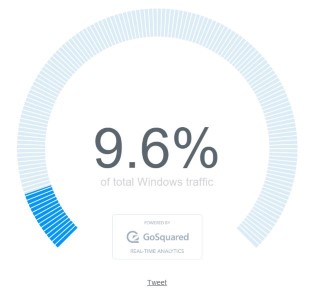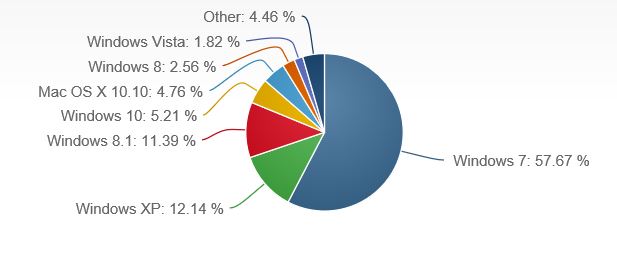75 Million Win10 Installations One Month Out by Ed Tittel
On August 26, 2015, MS made it known that the Windows 10 installed count had surpassed 75 million. A quick look at the calendar shows me that 8/26 is exactly four weeks after 7/29 (the day Windows 10 hit RTM status, and Build 10240 became available to non-Insiders). A fascinating article on Supersite for Windows entitled “Windows 10 Momentum” digs into these numbers, and also exposed me to a new and very different, UK-based source for online user population data named GoSquared.com.

Last week, I blogged about an earlier 67-million-installed figure from unofficial sources that apparently equated to a fraction under 1 percent of all desktops it monitored through its tens of thousands of sites. GoSquared, on the other hand, reports some very different statistics — namely, instantaneous readings that vary from a high of just over 20% on August 23 to a low of under 1% right out of the starting gate on July 28 (as far back as its data goes). I believe these numbers reflect the breakdown by Windows version (and the line graphs underneath the circular indicator shown above show the breakdown across Windows 7, 8, and 10 for the entire time line covered) at any given point in time graphed. What’s not clear to me is the size of the population that’s being monitored and how that population is composed. GoSquared is a subscription service which makes the population self-selecting (those willing to sign up and pay for its services).
What’s fascinating is the idea that if Windows 10 is indeed roughly 10% of the Windows population active on the Internet at the time the graph was generated, the total number of Windows users online falls under 1 billion. This makes more sense than the 17 billion figure I calculated last week, predicated on the assumption that all Windows users were online and that the number of online Win10 users scales smoothly into the overall number of Windows users across all versions. Alas, that’s not really the way that it works, because at any given moment we’re measuring only a fraction of the global population, excluding the approximately 1/3 of the globe that’s in its prime sleeping hours at that time. Assuming instead that we can measure a maximum of 2/3s of Windows users at any given moment, that raises the global Windows population to something in the neighborhood of 1.12 billion. But given the wide range of fluctuation in the Windows 10 numbers available by tracking the graph on GoSquared across the past week (which runs in a range from over 8 percent to under 15 percent of active users at the time of monitoring) we get a sense that the population is pretty fluid and changeable in size.
What I do like about these numbers is that they show a more realistic notion of what the overall population of Windows users might be, and put Windows 10 in a more realistic position vis-à-vis the other common versions in use (though XP and Vista are not on this radar). It remains very interesting to watch Windows 10’s explosive growth, and to see how that curve continues to climb. To me, that makes upcoming quarterly and yearly milestones equally interesting, especially as indicative of overall trends.
[Note added 9/1/2015 AM:]
When I checked NetMarketShare for Windows 10 yesterday, it was still reading under 1% (0.93, to be more precise). As of this morning, however, that figure has zoomed to 5.21%. This is much more in line with what I thought it should be, at about half of what GoSquared is reporting. I’m sure there’s a story in how those numbers could jump by 560% in one day, but I’m also pretty sure we’re not going to learn the no-doubt “oops!”-related details involved. Here’s the screencap:
 What’s truly amazing about this 5.21% number is that Windows 10 achieved in 28 days what it took Windows 8.1 almost one year to achieve (the 8.1 number was 5.92% by the end of July 2014, about one year after the RTM date). At this rate (which obviously cannot be sustained for too much longer, though it will be interesting to see how long this run lasts), Win10 could conceivably surpass Win8.1 some time in early November! We’ll see…
What’s truly amazing about this 5.21% number is that Windows 10 achieved in 28 days what it took Windows 8.1 almost one year to achieve (the 8.1 number was 5.92% by the end of July 2014, about one year after the RTM date). At this rate (which obviously cannot be sustained for too much longer, though it will be interesting to see how long this run lasts), Win10 could conceivably surpass Win8.1 some time in early November! We’ll see…
Note:
The article was originally published by Ed Tittel @ TechTarget: IT Knowledge Exchange on August 31, 2015. It is reproduced on this blog with an author’s permission.